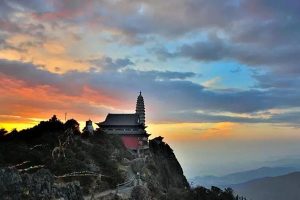
Yunnan Cycling Tour along The Burma Road and Stilwell Road from Yangbi to Yongping
On October 6
Yangbi bridge(漾濞桥) — Taiping town(太平乡) – Yongping(永平) 75 km
At 9 am, crossing the Yangbi river, start today’s ride. Less than 100 meters after crossing the bridge, the road began to violently uplift, for the car was just about to climb the slope of the setting, two days down has been very abusive.
And then about 8 km it’s flat road, and while the slope has been maintained at an awful 8 percent or more – about the same as most underground garage ramps – it’s not exactly fatiguing because the road is in good condition. After half an hour of climbing, the elevation is up to 700m, and you can already see the Hexi village(河西村) below you and the Yangbi town(漾濞县城) in the distance.
The road under foot is the old road of Burma road(滇缅公路) that does not coincide with national highway 320. The long slope was the Yangbi slope(漾濞大坡), which was very familiar in childhood. In the early 1980s, Yunnan province opened five counties near the border, then known as Outside Five Counties or Waiwuxian(外五县), to trade with myanmar. The most impressive products of the time were cheap electronic watches, even at the time, and a kind of snack with strange characters on it, such as Fried beans. Outside Five Counties is roughly the west-end of the Burma road Ruili(瑞丽), Wanding (畹町) around, the opening of this area makes the long silent Burma road suddenly gained a new life, vehicles central to the world, it seems that the resumption of the Anti-Japanese War period.
At that time, the 320 national highway did not exist, we still along the old Burma road west. The road from Yangbi to Yongping begins to get back in sight. At that time, there were many relatives and friends who had been going back and forth in the other five counties. When people were chatting, they often mentioned the so-called Yangbi big slope. Every time they mentioned it, the narrator could not help showing a look of fear. Want to know, the highway of yunnan province at that time, hang on high mountain mostly, wide however a few meters, on car travel its, always unavoidable have the worry of overturn, and everybody is used to this kind of road early, even take pride in this. What does it look like to be on a highway that makes the old drivers used to the mountain trails tremble? This doubt has been hovering in my mind for more than 30 years, and today it can finally be solved.
The image below shows the cycling route today, one can see YangBi County(漾濞县) old within the territory of Burma road sections (brown) and its south side of 320 national highway(320国道) and the relationship between the G56 highway(G56高速公路). As can be seen from the picture, in terms of mileage, the old Burma road is obviously a shortcut to yongping county(永平县). However, in most cases, the 320 national highway that overlapped with Burma road, why did it abandon the old road in this place, and chose to go south.
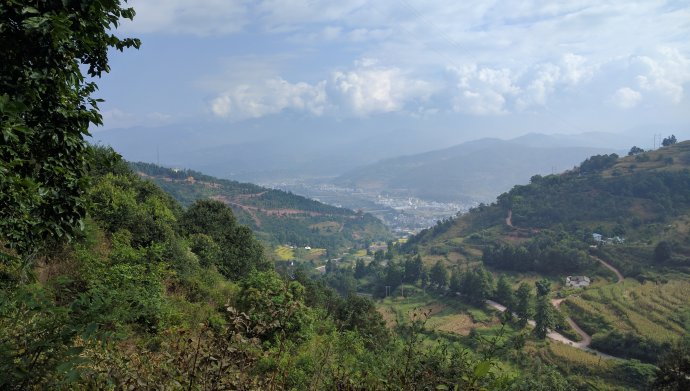
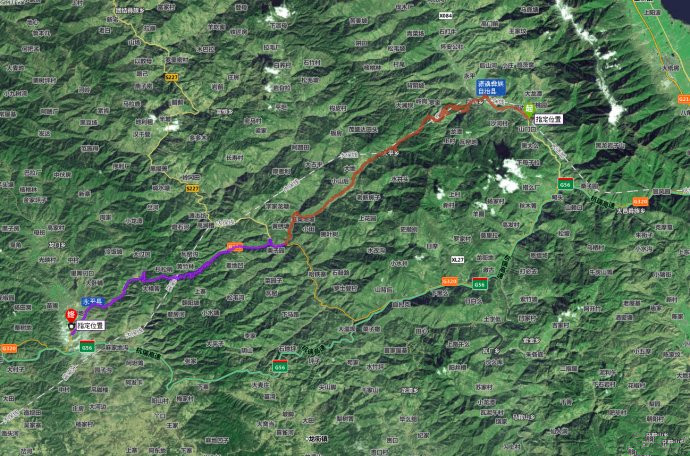
The reason is simple: the old road is so steep. According to national standards, the maximum gradient on a first class highway such as the national highway should not exceed 8 percent and can be relaxed to 10 percent occasionally. Today, more than 12 percent of hairpin curves abound on this road, and on one side of the road, there are often deep valley cliffs. Then we finally know why the Yangbi slope(漾濞大坡) makes the old drivers turn off. But now it’s climbing up flat asphalt, and while it’s getting a little tired, it’s not dangerous.
When it comes to danger, the parched snake can be seen across the hot road within a few tens of meters, reminding the side of the road that there is no safety in the grass.There are few cars on the roads, and a few yi villages can be seen occasionally. Lonely road, singing birds mountain quiet.
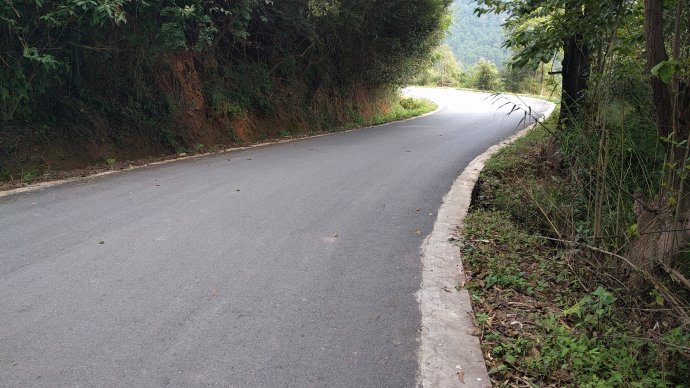
Panting up the slope, watching the road stretching ahead, my heart began to get frustrated. It looks like it’s late again! According to the record, this section of road should be tang shi lu just right, it seems that the two years just renovated. This road, the history of the fans how can be difficult, nostalgic feelings, but to whom? Thumping his chest for a few more kilometers, the tarmac disappeared near the 425km milestone(425km里程碑) and Tangshi road finally appeared. On the spur of the moment.
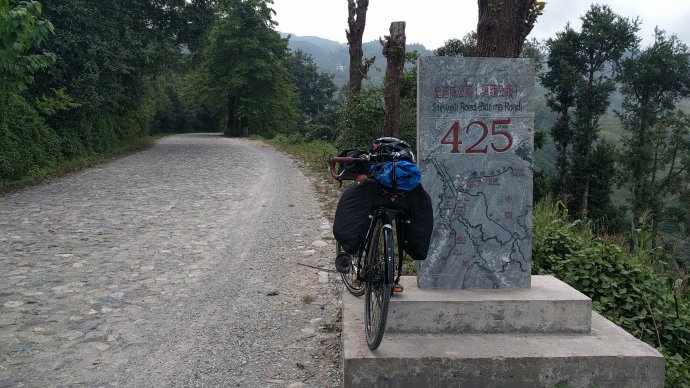
Tangshilu(塘石路), referring to a form of pavement made of pebbles or even gravel, is said to have originated in Europe and was considered the best road in the years before cement and asphalt became popular. During Quomintang period(民国时期), there were many such roads in big cities. Until the end of 1980s, the most prosperous jinbi road in kunming city still had a small section of such roads. However, the Burma road during the war of resistance was of course important, but it did not have the luxury to lay all the road as Tangshilu(塘石路).
The present Tangshilu(塘石路), are in the sixties and seventies laid. But even that is more historical than asphalt.The initial excitement over tangshi road lasted only two minutes because the road was so unbike-friendly. The ride was a steel station wagon, which had no shock absorber of its own and had a slight shock absorber effect only on its own elasticity. So quickly was upset hands and feet, five dirty move.
What’s more, the vehicles keep bouncing on pavements large and small, and each bounce takes a lot of kinetic energy, so they have to put in more energy to climb the slope. The measured data show that the slope of the whole tong shi section is no less than 10%. Even if the road surface is smooth, it is not easy to ride, let alone in such a road condition.
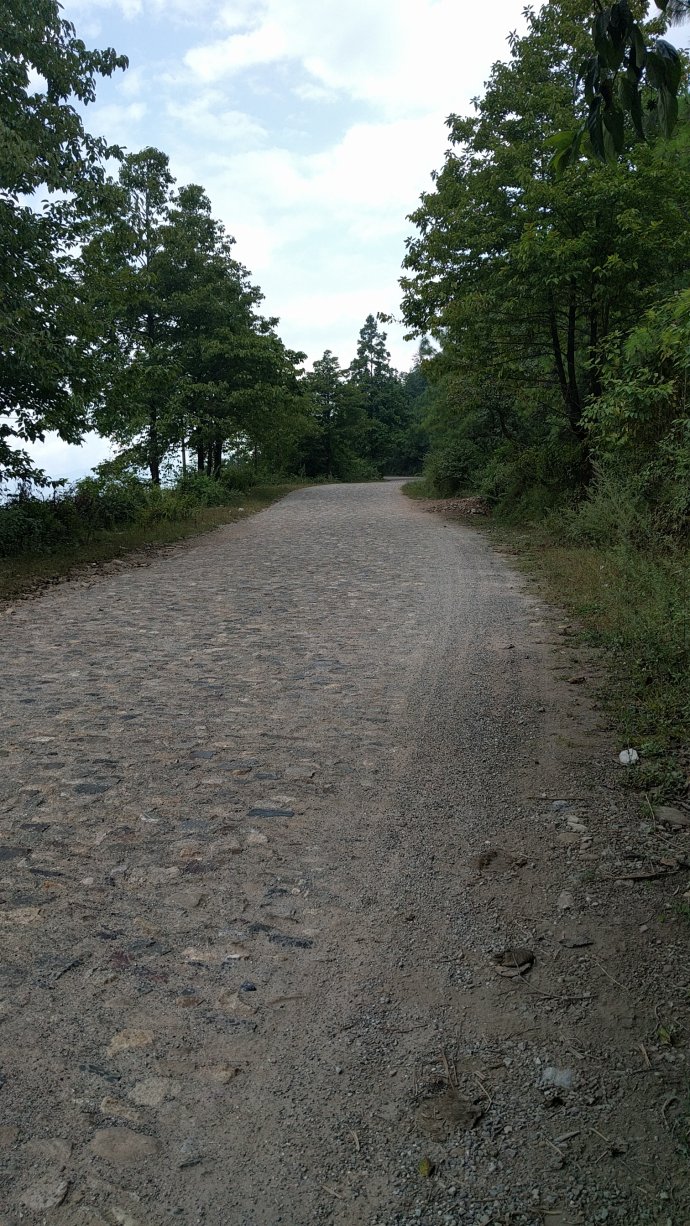
Struggling to find a slightly flat road ride, the road shoulder proved to be a barely acceptable location, but there were often piles of rubble and several near-misses. The thought that there is at least 30kmTangshilu(塘石路) road ahead makes me shudder.After struggling for a dozen kilometres at a pitiful 5km/h, climbing up a big hill, I was pleasantly surprised to find that it was asphalt again, and downhill! The good downhill stretch, which lasted for about a decade, was the happiest moment of the day.
At 30The average speed of km/h is going down the slope.Look at the map, the bottom of this big slope should be Taiping township(太平乡), roadside gradually inhabited, and a variety of Burma and Burma kilometers of monuments are more and more. For example, this so-called roller.
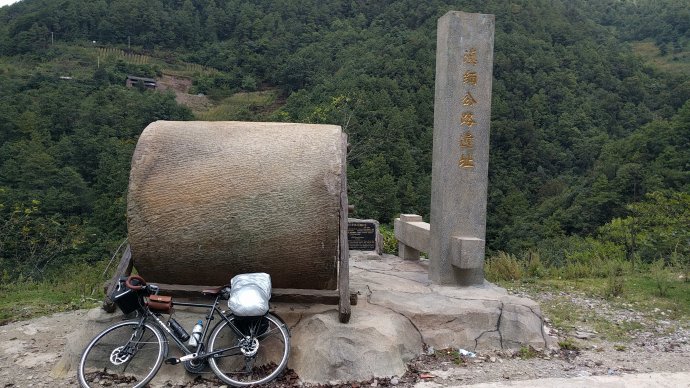
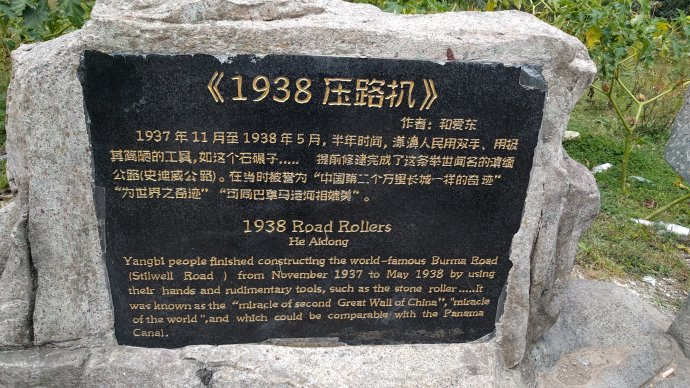
At noon, I solved the lunch problem by the side of an unknown wooden house and avoided a sudden shower.
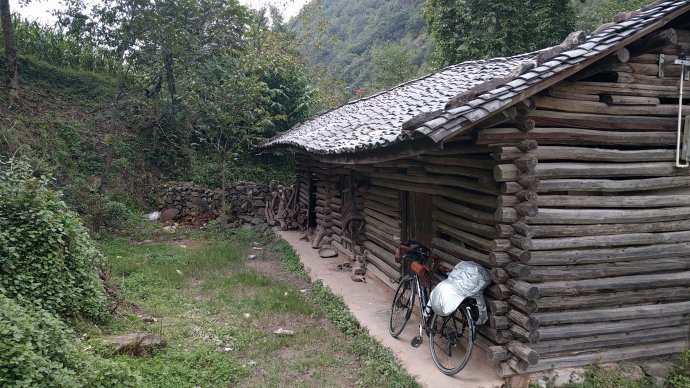
During the lunch break, my mind was free to recall what I saw along the way. But the steep and narrow road was not easy to walk, and how difficult to build. Some words and images related to the road repair in that year, suddenly there were tears. There was a time when I would use my lunch break to tell my colleagues about history.
Once, when talking about the war of resistance, I used a few photos to summarize the war, and this is one of the photos that I chose to show to you at that time. This is a typical female of han nationality in Dali region. Although her costume is strongly influenced by the white costume, her little feet still expose her genus. Judging from the photos, her job is to break the stone. The gravel is mixed with sand and dispersed on the road surface, which is then ground down with a stone roller.
Breaking rocks was the lightest work of the time, and many of the children along the way did the same. Personally, the awakening of the people and the formation of the awareness of the Chinese nation is the biggest gain that the war of resistance has brought to this country. And this picture, in a sense, represents that state of awakening.
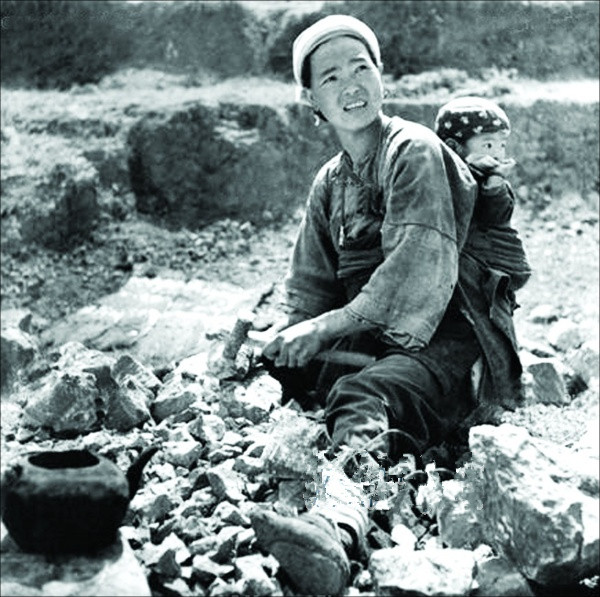
But now, walking on this road and looking at this picture, there are not so many high thoughts, but simply think, how difficult they are. And even the small feet of women carrying infants, when the old and weak women and children are to be mobilized to serve the war, how difficult that war.
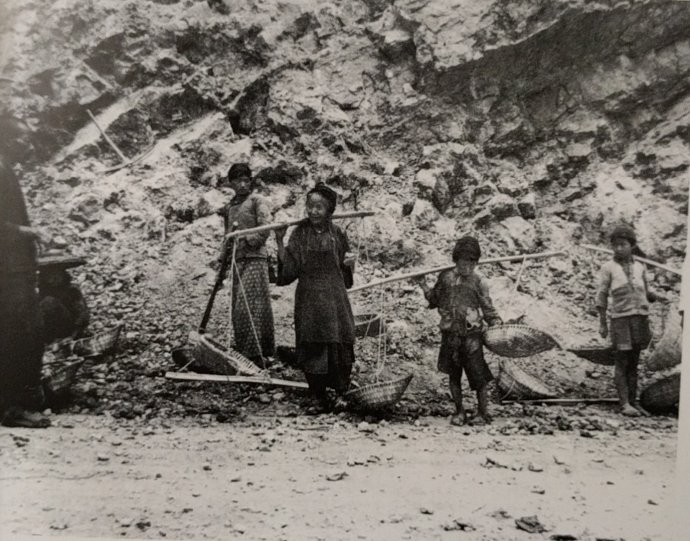
Feeling good for a long time, continue to move forward. After passing through the township, tangshi road reappeared. The slope is getting bigger and the road is getting worse. By the time you’re halfway up the hill, there’s not much stone left on the road. This was a more primitive section, whose appearance was very close to Burma road during the Anti-Japanese War.A monument on the side of the road turns resentment into admiration.
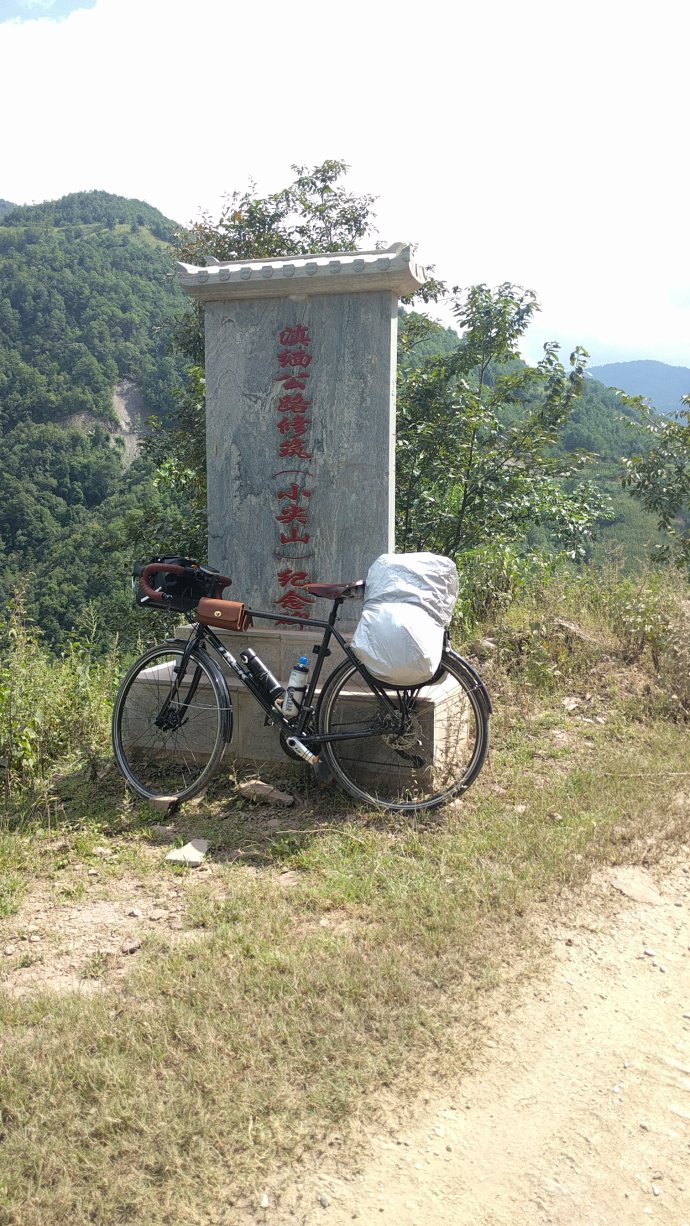
No wonder this section of road is so bad to walk, it turns out that this is the Yunnan-burma road with high construction difficulty, sacrifice huge and famous small pointed hill! On the left side of the road is a ravine hundreds of meters deep. On the right side of the road, on the hard side of the mountain, the marks of the axe are still vivid.
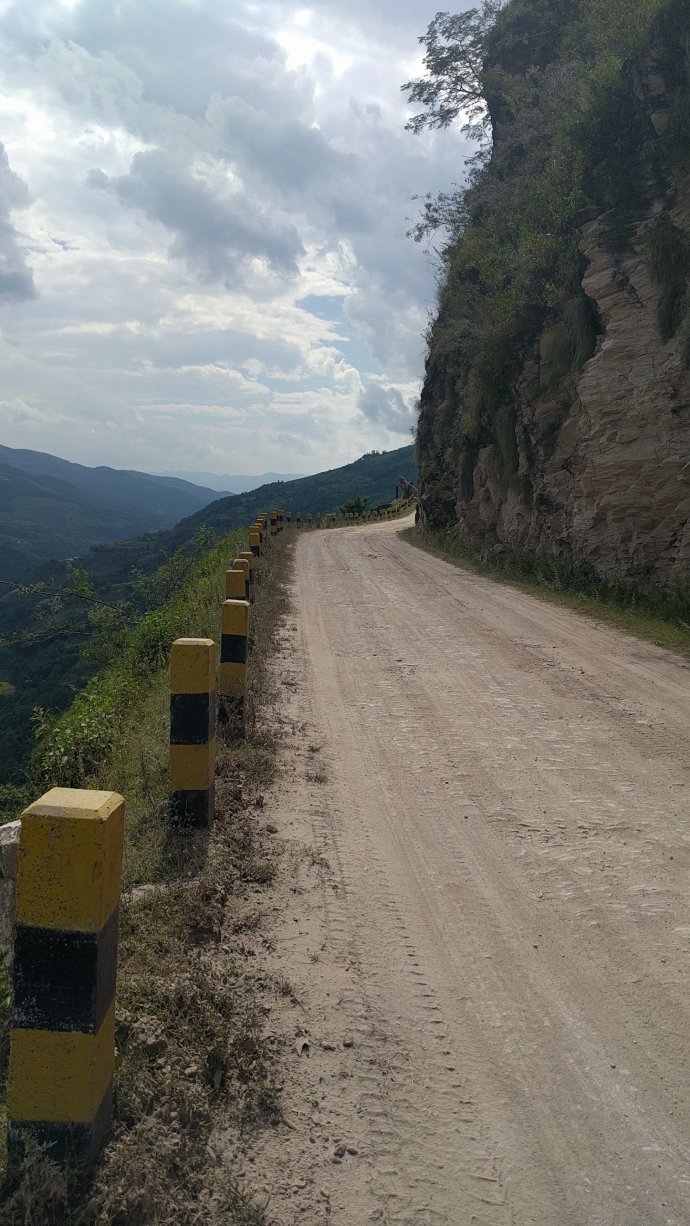
By the roadside, a statue recreating the scene of opening the small peak road section of the same year stands out impressively, its name is “pry open the blood line”(Qiaokai Xuexian撬开血线), and there is short saying: Go ahead, pry open this cliff, the front is the dawn! Xiaojianshan Mountain (小尖山), a tunnel of 102 Xiongguan Pass(百二雄关), 2000 km Burma road and 23,000 km Southern Silk Road throat! Was cleared by the yangbi people!
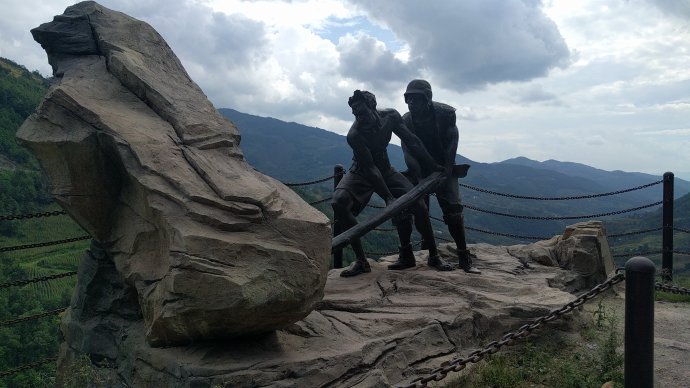
Worshipful, frightened ride through this dangerous road. After this statue, actually a long way to the main slope, but the speed is not up. We’ve talked about the pain of climbing a hill on a bumpy road, but on a road like this, the downhill is actually more deadly. Because if you go down a hill a little faster, you’re going to want to be jolted out of it, and if you go at a higher speed on a slightly protruding rock, you’re really going to fly out. So, you still need to control the speed just like walking.
The road gets narrower and narrower, and it’s becoming more and more like a cross-country ride if you thought you were riding on a road.
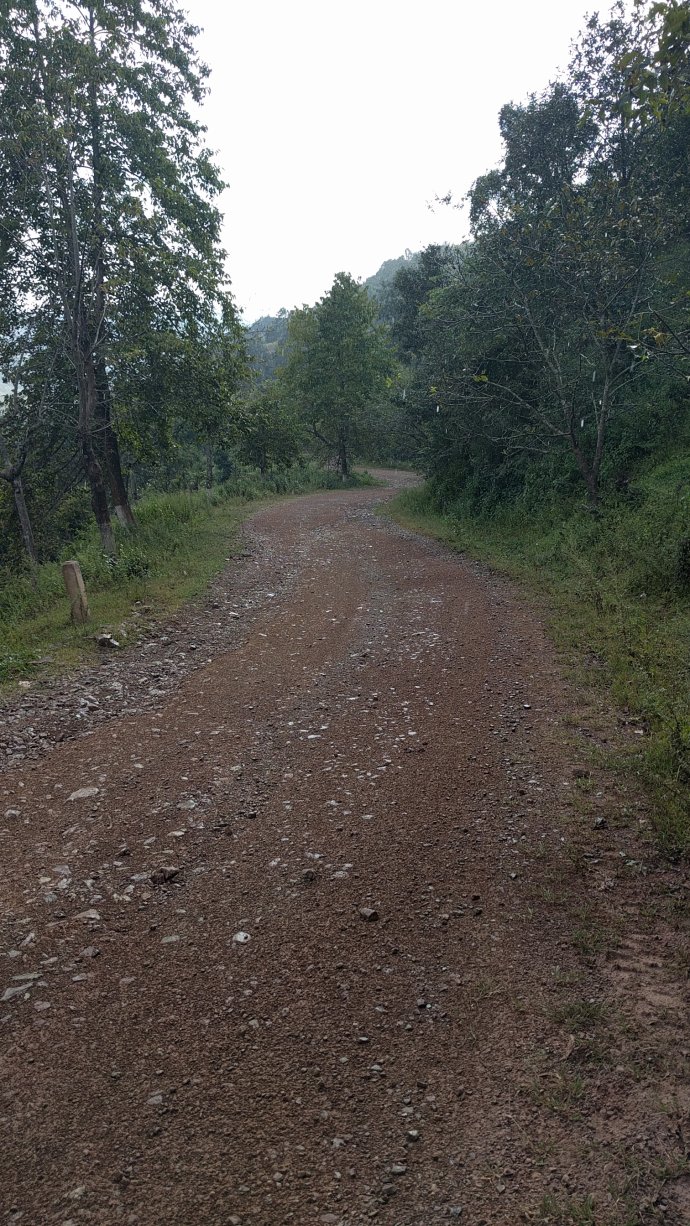
When the rain comes, and often after the dress is finished, the rain stopped wind stopped, sun made people hurriedly put raincoats or stormwear. So repeated several times, really I was so bored that I decided not to worry about the rain. Unfortunately, when the next shower first came, the ground was still wet, and a muck truck suddenly appeared behind. ..Just when I felt that I was in pain, a river began to appear in front of me on the left. Not far away, there was a red bridge across the river. It was the Shengbei bridge(胜备桥)!
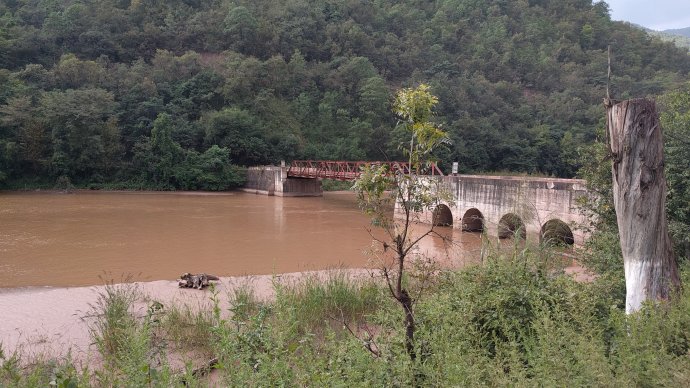
This bridge is the second bridge of Burma road. It is named Shunbi bridge (顺濞桥) because it crosses the Shun bi river(顺濞河). The beret-style(贝雷式) steel bridge, already a third-generation Shengbei bridge(胜备桥), was built by U.S. engineers. The Shengbei bridge was originally located in the lower reaches of the river to the left of the photo, a few metres from where it is now.
In the 1980s, the whole bridge was moved up due to the construction of the reservoir, and because the reservoir made the river wide, a section of cement bridge was connected at both ends of the steel bridge, which became what it is today. In any case, it was one of the largest objects seen in days of resistance along the way, and it was well worth cheering.
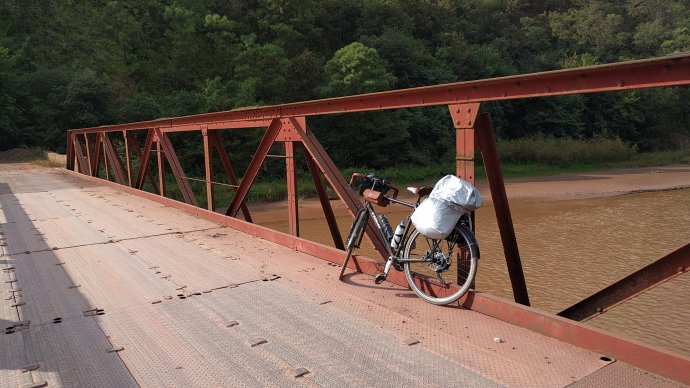
The Shengbei bridge(胜备桥) was changed from a wooden bridge at the beginning, to a stone bridge, and finally to a steel bridge. During the construction process, it was broken down many times and caused a large number of casualties. After the Shengbei bridge, it should be on the national highway soon. From Yunnanyi(云南驿) to Yangbi(漾濞), more than 100 kilometers are on the 320 national highway, the road conditions are quite good. For a moment I was filled with hope.
Half an hour later, I walked past the once famous and now run-down Huanglianpu shop(黄连铺), and finally stumbled to the intersection of the old road and national road. The national road ahead, as expected as flat and open, people have the urge to worship.
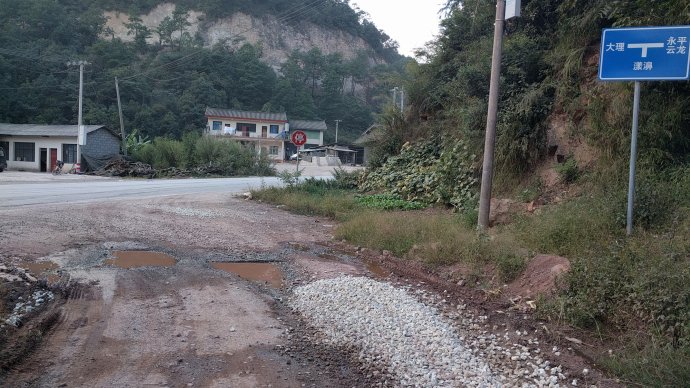
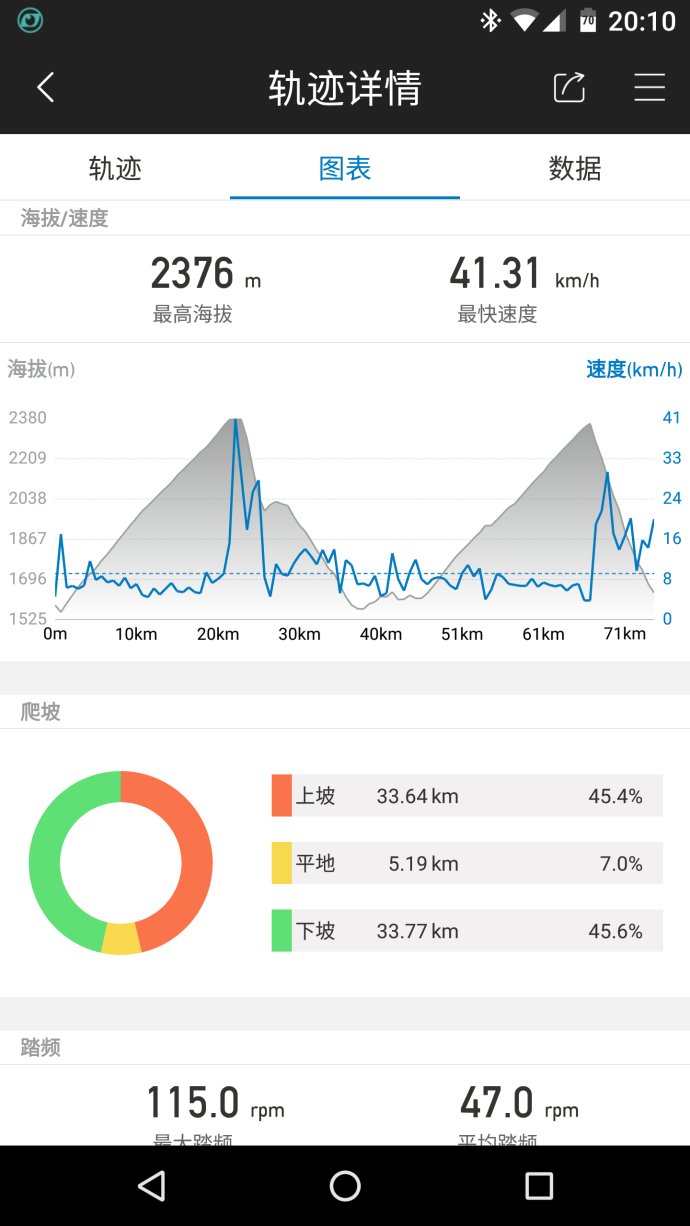
However, three minutes later I knew how naive I was. The G320, which starts at this intersection, is under major repair. From here to Yongping county(永平县), more than 30 kilometers of road surface have been uncovered, not an inch of ground. The road still has a mountain to climb. The large uphill section on the G320 on the right is almost as steep and long as the one on the left that took a whole day to turn over. Now, it’s five o ‘clock in the afternoon.
When the road is cut open and the road under repair is covered by numerous carts, sometimes the dust can barely cover the feet, and underneath the dust, it can be a big pit. Finally, it is realized that there are more unbike-friendly road types in this world than tong shi lu, the floating road.During the day it was possible to find some stronger places on the road to ride on, but the sun soon set and night was closing.
Today, I had prepared for a night ride, the headlights were full, and there were spare batteries, but I had no idea that I would ride on such a road at night.Say night ride, in fact should be night push. The headlights are bright enough to tell if the road ahead is suitable for riding. On the right side of the road, although it is not clear exactly what is, but faint sound of water, but enough to imagine a deep ravine. In this case, the safest way is, of course, the cart.
As you can see from the speed curve in the figure above, between 53km and 67km, you’re basically pushing the car. This ten kilometers, one foot deep and shallow for a full four hours walk. Up to the Mid-Autumn festival, at night, the air temperature in the mountains but 3 ° C, and occasionally shut the lights as was opaque…10 p.m., top of the hill.
A pot of hot water was pumped at a station, the body and mind were refreshed, the downhill road was acceptable, and the slope was carefully let down. 11 o ‘clock, finally arrived Yongping county(永平县城). It was one o ‘clock in the night after supper and washing.Today, it took 14 hours to travel a total of 75km, setting a record for the lowest speed. During the heart – stirring, the actual lack of external humanity.
http://blog.sina.com.cn/s/blog_5379fe130102wwho.html

 7 Days GolfingTour
7 Days GolfingTour
 8 Days Group Tour
8 Days Group Tour
 8 Days Yunnan Tour
8 Days Yunnan Tour
 7 Days Shangri La Hiking
7 Days Shangri La Hiking
 11 Days Yunnan Tour
11 Days Yunnan Tour
 6 Days Yuanyang Terraces
6 Days Yuanyang Terraces
 11 Days Yunnan Tour
11 Days Yunnan Tour
 8 Days South Yunnan
8 Days South Yunnan
 7 Days Tea Tour
7 Days Tea Tour
 8 Days Muslim Tour
8 Days Muslim Tour
 12 Days Self-Driving
12 Days Self-Driving
 4 Days Haba Climbing
4 Days Haba Climbing
 Tiger Leaping Gorge
Tiger Leaping Gorge
 Stone Forest
Stone Forest
 Yunnan-Tibet
Yunnan-Tibet
 Hani Rice Terraces
Hani Rice Terraces
 Kunming
Kunming
 Lijiang
Lijiang
 Shangri-la
Shangri-la
 Dali
Dali
 XishuangBanna
XishuangBanna
 Honghe
Honghe
 Kunming
Kunming
 Lijiang
Lijiang
 Shangri-la
Shangri-la
 Yuanyang Rice Terraces
Yuanyang Rice Terraces
 Nujiang
Nujiang
 XishuangBanna
XishuangBanna
 Spring City Golf
Spring City Golf
 Snow Mountain Golf
Snow Mountain Golf
 Stone Mountain Golf
Stone Mountain Golf


